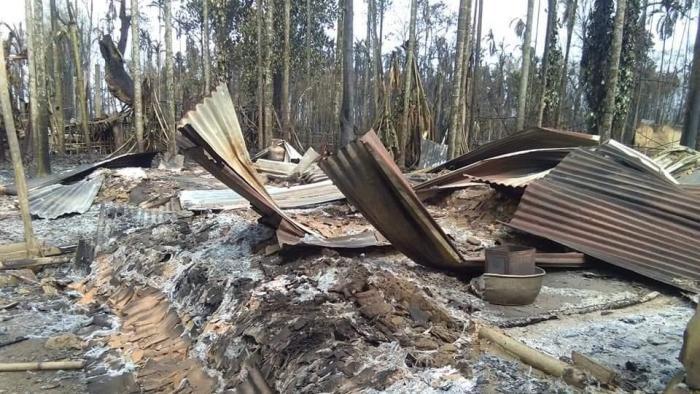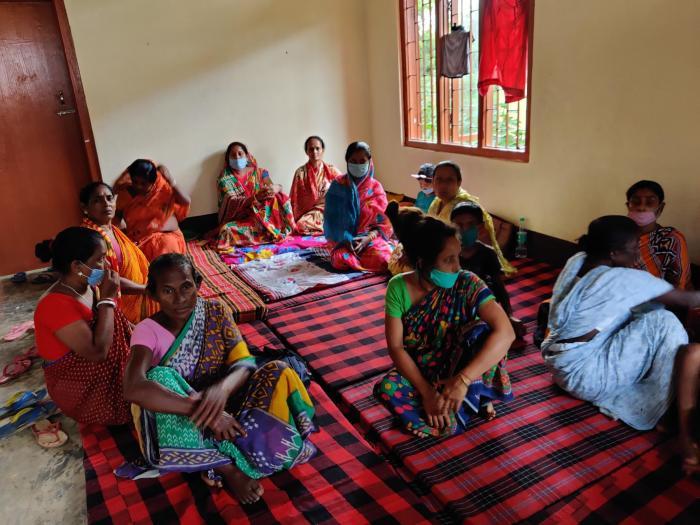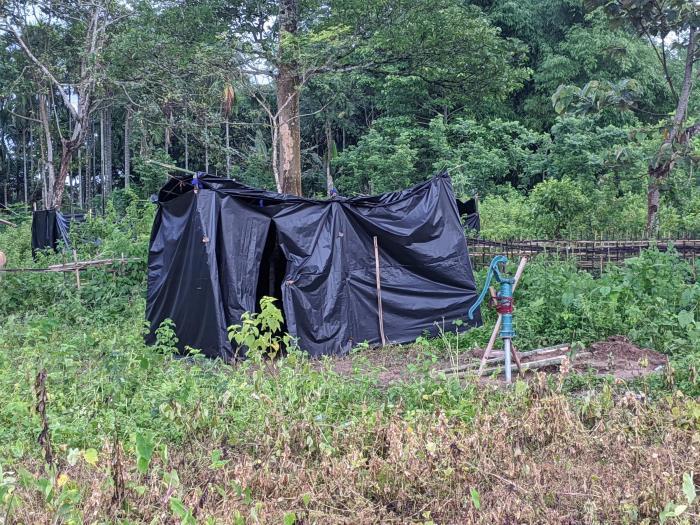Baghjan Blowout Ground Report: Displaced Locals Anguished Due to Lack of Clarity, Minister’s Casual Attitude
“The ground was constantly shaking, like there was an earthquake. Cracks were being formed on the walls. We could not hear others because of the noise. Fearing for our lives, we all ran outside our homes, on to the streets,” narrated an elderly woman from Notun Gaon while describing what happened on the night of June 9—when the oil and gas well no. 5 blew up and caught fire, incinerating everything around the oil field including Oil India Limited vehicles parked at the site, tea gardens, crop fields, and houses. The fire also claimed the lives of two firefighters working at the site. The well, situated at Baghjan had already been experiencing a blowout since May 27.
A local struggling to fish in the Maguri Beel contaminated with oil spillage on June 7
The first blowout that was experienced on May 27 had already threatened the existence of the Maguri-Motapung wetland, a famous ecotourism spot situated near the oil well. It is also home to many ethnic communities which are intrinsically related to the wetland. Almost all the communities are dependent on the wetland or the beel for their living. The beel has been highly contaminated with oil spillage and also due to the condensed gas settling down. The gas leak has also affected the biodiversity of the Dibru Saikhowa National Park situated near the well, endangering the lives of many birds and animal species. The larger and the subsequent blowout on June 9 has only increased the environmental and ecological damage.

House in Baghjan, destroyed in a fire outbreak.PC Credits: Monoj Hazarika
On June 9, fire outbreaks in nearby villages followed the explosion at the oil well. Social media websites were filled with terrifying visuals of many houses engulfed in the fire. Helpless, the locals had no other option but to flee with whatever they had managed to get hold of—small bags of clothes and caged poultry in their hands.
While after the first blowout, around 1,610 families were evacuated and sheltered in four makeshift relief camps, the figures increased as soon as the fire started. More than 7,000 people from the surrounding areas have been sheltered in 12 relief camps. Bandorkhati High School, which is about 10 km far from Baghjan, shelters 1,500 people, the Kordoiguri High School which is 20 km from the oil field is being used as a shelter by approximately 1,000 people. The other shelters are in close proximity to each other, in the same area.
Locals of Notun Gaon, however, allege that they were, until recently, neglected by the authorities and that they did not benefit from any relief plans, be it provision of shelter, relief materials or compensation for which they had also protested on the Kaliapani bridge many times. On the night of the explosion, residents of Notun Gaon were still in their homes. But panic soon swept through as the ground started shaking. “It sounded like big boulders rolling beneath the ground. We all ran out to the street,” said a local. In the midnight, on the locals’ frantic calls and requests for help, Dhrubojyoti Borah, circle officer of Tinsukia, reached Notun Gaon and after a long and heated discussion, the locals were reportedly asked to arrange a shelter for themselves. They were assured that relief material would reach them in the morning. The youths ferried the residents through the night to a public school in Guijan, a village near Dibru river. The school had been converted into a makeshift relief camp. “I have not had proper sleep since the blowout, something or the other keeps coming up, everyday,” said Dipankar, a resident of Notun Gaon.
Also read: Why Agriculture Remains the ‘Sink’ for Indian Capitalism
Although some of the villagers living in the Guijan camp have been making quick visits to their homes, all of them are afraid to go back and live in the village. “The constant tremors and the terrifying sound did not let us sleep anyway,” said a local.
In a press release, OIL had declared that a team from OIL and NEIST [North East Institute of Science and Technology] is to identify the location for installing broadband seismographs at various radial distances from the well. Five broadband seismographs are to be deployed. “Locations have been identified and preliminary civil work for deployment of the instruments is in progress.” says the press release.
Regional students’ organisations have been quick to provide help to the displaced residents of Notun Gaon. Although the locals initially hesitated to accept help from them as they thought it would absolve the government and the authorities from their responsibility, they are now accepting such help as the government and OIL, too, have started providing them with the much-needed relief material. Another relief camp has sprung up in a similar fashion in the Dhelakhat area which is very close to Notun Gaon. Total number of relief camps adds up to 14 if we include the new camps in Guijan and Dhelakhat.
While OIL has been providing “sufficient relief material” to the displaced locals, and in many of the press releases has assured that such help would continue, the locals are not satisfied with how the PSU is handling the situation. The declared compensation of Rs 30,000 per affected family has still not reached anyone.

A congested room in a relief camp near Baghjan
Locals have also complained that they have not been briefed by OIL nor by the government about the situation and about when they can return back to their homes. “We don’t want anything from them, we only want the fire, and the sound, to be controlled.” said a woman in a relief camp. “The living condition is abysmal here. Around 20 people are forced to sleep in a single room, on the floor. There’s no peace here.” said another woman.

A makeshift toilet set up in the Bandorkhati High School relief camp
Although OIL has claimed that hygienic toilets and lodging are being provided, the ground reality is a contrast. Fear of the novel coronavirus transmission also looms large amid the cluster of people. Although OIL has declared in a press release that proper measures have been undertaken for sanitisation of the camps and for implementing the government norms, norms like social distancing are still a luxury for many living at such makeshift relief camps.
The displaced locals are anxious and worried about the future. Most of their livelihoods were dependent on Maguri beel. Others farmed on the lands and some were dependent on livestock and poultry. Now, the beel and the land are contaminated with oil spillage and condensed oil, while most of the livestock and poultry are either dead or suffering from health problems. Whether OIL’s relief package could help overcome such long-term issues remains a crucial question.
Minister of Petroleum and Natural gas, Dharmendra Pradhan, and Chief Minister of Assam, Sarbananda Sonowal, have paid a visit to the site and assured locals that the situation would soon return to normal and that the locals would be adequately compensated. Similarly, Industries and Commerce Minister, Chandra Mohan Patowary visited the relief camps and was heard downplaying the situation when he said, "In Russia, a massive fire continued to burn for almost 80 days. This fire is nothing compared to Russia. Such fires have taken place in Iran also." The locals were outraged by his sluggish attitude triggering protests throughout relief camps. "Sir, please do not compare it with other [incidents]. If we look at the Russian government’s compensation, we know that the Indian government would not do that," one of the villagers said.
Protests were held across Tinsukia district of Assam on Thursday, June 11. The district unit of the All Assam Students' Union (AASU) burnt Patowary's effigy and strongly condemned the minister's statement. Protests by regional students’ organisations including All Moran Students’ Union (AMSU), Assam Tea Tribe Students’ Association (ATTSA) at oil well sites including places like Makum, Barekuri, Hapjan, Lankashi, Nagajan, Hebeda and Dhakul area continued. An indefinite sit-in has been called at the relief camp of Guijan to protest against the indolent attitude of the government and OIL.
Also watch: Way-Forward: COVID-19 and Indian Agriculture
Get the latest reports & analysis with people's perspective on Protests, movements & deep analytical videos, discussions of the current affairs in your Telegram app. Subscribe to NewsClick's Telegram channel & get Real-Time updates on stories, as they get published on our website.
























